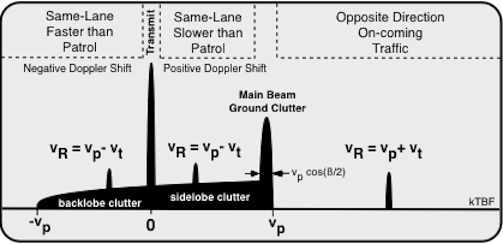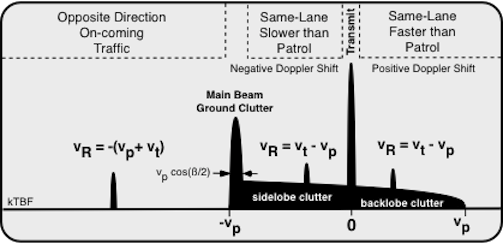Front Antenna

ß = Beamwidth
Moving-mode radar is slightly more complicated. An on-coming target vehicle's echo is the sum of the patrol vehicle speed plus target vehicle speed - closing speed. The radar subtracts patrol vehicle speed from the echo to get target vehicle speed.
| 1.) | GROUND Echo | -- to determine patrol vehicle speed |
| 2.) | TRAFFIC Echo | -- Speed relative to moving radar |
Moving mode opposite direction on-coming traffic echoes are the sum of patrol vehicle plus target vehicle speeds. Moving mode same direction traffic echoes are the difference of patrol speed minus target speed.
| Opposite Direction Traffic | Same Direction Traffic | |
| VR = Vp + Vt | VR = Vp - Vt |
VR = traffic speed relative to radar
Vp = patrol speed
Vt = traffic actual speed

The transmit signal interferes with same-direction traffic traveling near the patrol speed. Same-lane mode cannot measure traffic traveling within ± 2 to 5 mph of the patrol vehicle.
The ground reflection interferes with slow moving same-direction and opposite direction traffic. Moving mode cannot measure traffic traveling slower than 15 to 20 mph.
Rear Antenna
A radar with a rear antenna has negative Doppler's. Moving mode opposite direction receding traffic echoes are the negative of the sum of patrol plus target vehicle speeds. Same direction traffic echoes are the difference between target and patrol speeds.
| Receding Traffic | Same-lane Traffic | |
| VR = -Vp - Vt | VR = Vt - Vp |
VR = traffic speed relative to radar
Vp = patrol speed
Vt = traffic actual speed

Moving mode ground clutter consists of reflections from the ground and any stationary objects. Ground reflections come in from all angles, strongest reflections from the main beam, weaker reflections from the side and back antenna lobes. The reflections are Doppler shifted between plus and minus patrol speed (±vp). Regions clear of ground clutter are limited by radar receiver noise and background interference and noise.
The largest and strongest ground clutter is in the main beam with a Doppler spread of patrol speed multiplied by the cosine of half beamwidth (vp cos (ß/2) to vp). The faster the patrol speed and the larger the antenna beamwidth, the wider the speed spread.
Moving mode reflections are Doppler shifted by traffic speed relative to patrol vehicle speed.
SPEED TERM SIGNS
The target and patrol vehicle speed terms (v and vp) are the negative of the terms in the above equations for some scenarios. Front antenna same direction traffic uses a negative speed term (-v). Rear antenna receding traffic and patrol speed use negative terms (-v and -vp).
